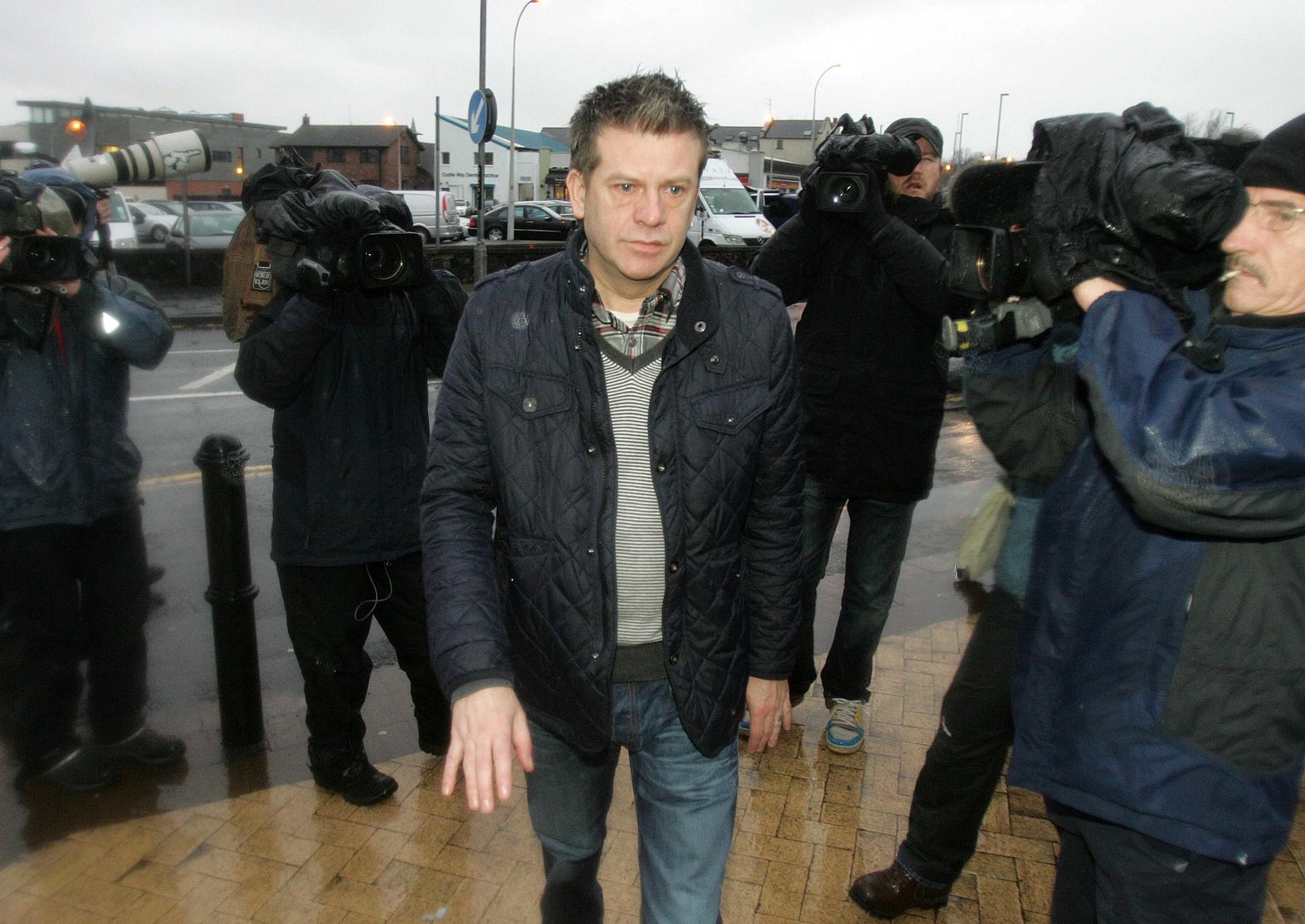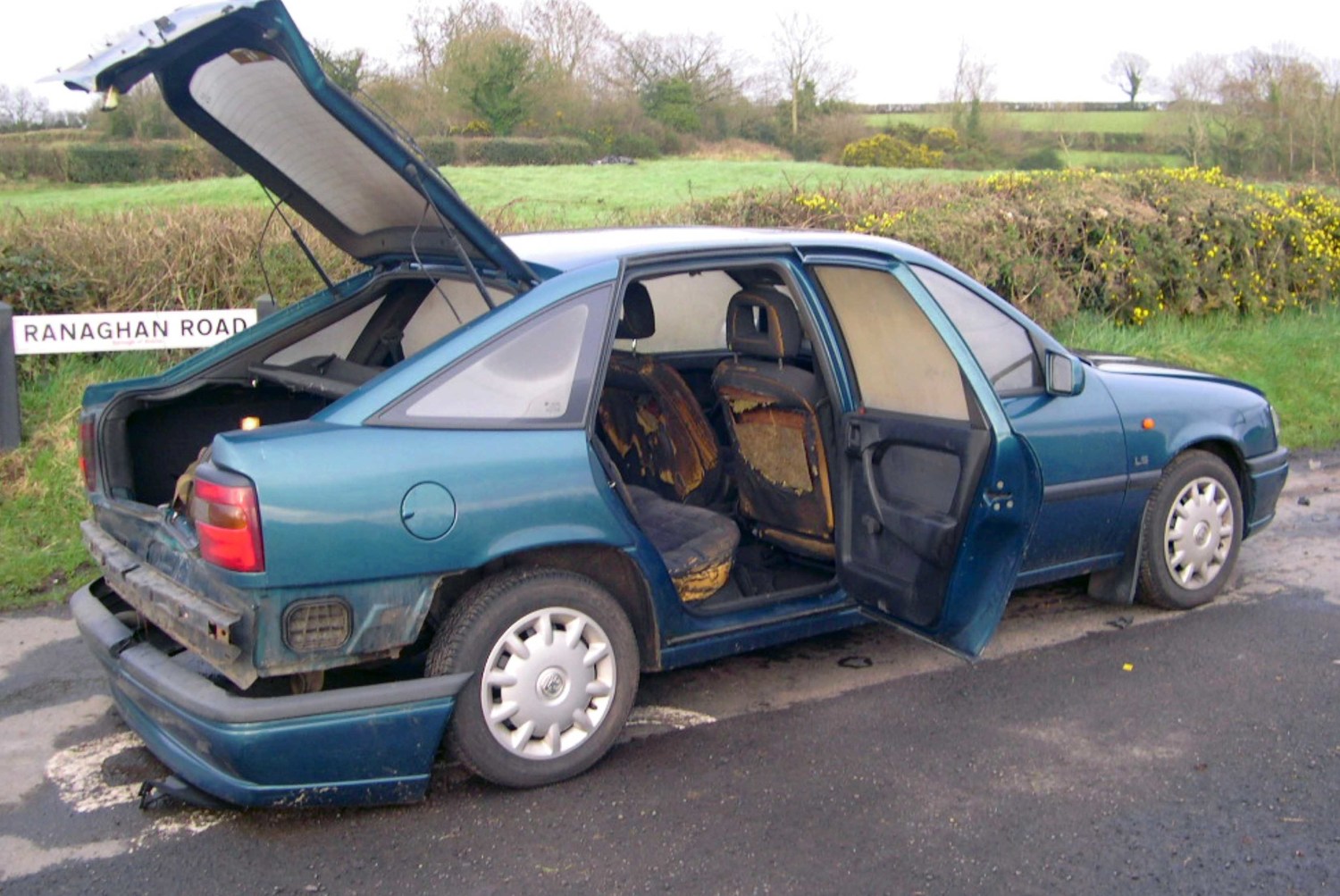The Massereene murder trial has been told that a second person’s DNA was found on a matchstick used to try and destroy the killers’ getaway car, as well as that belonging to murder accused Brian Shivers.
Magherafelt man Brian Shivers is accused of involvement in a Real IRA gun attack on Massereene army barracks in Antrim in March 2009, which resulted in the deaths of sappers Mark Quinsey and Patrick Azimkar.
Shivers (47) is accused of attempting to destroy the killers’ getaway car, which was found partially burnt out seven miles away shortly after the attack.
A crucial part of the prosecution case against Shivers is the presence of his DNA on two matchsticks and a mobile telephone found inside the vehicle.
Today (Wednesday) Forensic Scientist Andrew McDonald told the court that he had only become involved in the case last month after his colleague, Dr Emma Watson, who had carried out the original DNA tests on the items recovered from the car, was declared medically unfit to take part in the trial.
Mr McDonald was asked to re-examine a series of items, two matches found inside the getaway car, another matchstick found outside the vehicle and DNA swabs which had been taken from a mobile phone found in the killers’ Vauxhall Cavalier car.
The DNA expert told the court that he had compared miniscule samples of DNA recovered from the vehicle, which were a billion times smaller than a gram, which linked Mr Shivers’ DNA to the matchsticks found in the getaway car.
He stated:“In my opinion DNA which could have originated from Mr Shivers was detected on the two matches, item WMR13 combined. The results are what I would expect if he had contributed DNA to the result obtained. I have estimated that the probability of obtaining the matching DNA profiles, if the DNA detected on the matches originated from someone who is unrelated to Mr Shivers is less than 1 in 1 billion.”
Counsel for Shivers, Orlando Pownall QC, subsequently told the court that Brian Shivers was not disputing that his DNA may have been on the match sticks and mobile phone but contested the circumstances in which his DNA had been placed on the items.
Meanwhile the court was told that forensic experts had also found a second DNA profile belonging to another individual, identified only as G McG, following a forensic examination of the matchsticks.
The court was told that Mr McDonald’s predecessor, Dr Watson, had ruled out G McG’s DNA profile found on the matchstick.
However when questioned as to whether he now accepted that a mixed DNA profile, not belonging to Mr Shivers, was also contained on the matches, Mr McDonald said:
“Yes I accept that it could be a mixed profile that we’ve seen these two low level possible components that may indicate DNA from somebody else.
“So if we accept that they’re genuine components, yes, there’s an indication that it could be DNA from more than one person, yes.”
The court was told that forensic experts had tested the matchsticks for DNA from two men, identified only as D McG and G McG.
Questioned as to whether DNA tests had identified G McG’s profile on the matches, Mr McDonald said:
“I can’t exclude him as being a potential source of that DNA if it’s genuine.”
Mr Pownall asked: “So your answer would be, in answer to the question: Could either of these persons (D McG and G McG) have contributed to the DNA profile which was obtained from that item, WRM 13?"
Mr McDonald: “My answer would have been yes.”
On Monday the Detail revealed that the matches recovered from the getaway car had been placed into the same forensic bag, potentially contaminating each other.
Questioning the forensic expert about the possible contamination of placing the two matches in the same evidence bag, Mr Pownall asked:
“Let’s just stick with the matches for a moment, that is the two inside the car.
“We can all be wise after the event, but would it be fair to say that it would have been better from everybody’s point of view if those two matches had been bagged independently, the one of the other?"
McDonald: “I guess, maybe."
Mr Pownall: “If you put two matches together, and matches have rough surfaces, and where you’re dealing with these almost infinitesimally small bits of DNA, if they’re next to one another in a bag then one can rub DNA onto the other?”
Mr McDonald: “Yes, there is the potential for that to happen, yes.”
Mr Pownall: “Of course, and I mean that’s not a laughable flight of fancy, is it?"
Mr McDonald: “No, no.”
Mr Pownall: “ And so it may be that had those matches been independently bagged and you’d swabbed them the result would have been on one match nothing, and on the other match a profile?”
McDonald: “Yes that’s one outcome”.
The DNA expert was questioned as to whether it was possible for one of the killers wearing gloves to have used the matchsticks to set fire to the car without leaving his DNA.
Mr Pownall: “You simply could not say, could you, that the DNA on that match was left by the last person who touched the match?”
“No,” Mr McDonald replied.
The trial continues.
MASSEREENE MURDER TRIAL LATEST UPDATE – THURSDAYThe Massereene murder trial has heard that at least four DNA profiles, other than that of the accused Brian Shivers, were found on items recovered from the Real IRA killers’ getaway car.
The Magherafelt man is on trial for the murder of sappers Mark Quinsey and Patrick Azimkar, who were shot dead by Real IRA gunmen outside Massereene army barracks in Antrim in March 2009.
The court was told that DNA found at the scene, which was matched with the National Database, identified an unnamed individual in the Staffordshire police area.
Forensic science expert Andrew McDonald confirmed to the court that initial DNA testing on items recovered from the scene were later found to have been wrong as incorrect data had been used.
The court was told that a series of DNA profiles, other than Brian Shivers, were found on a range of items at the scene of the partially burnt out getaway car.
Up to four DNA profiles, other than that of Brian Shivers, was found on a match stick (labelled as evidence item JC5) discovered outside the getaway car.
Defence counsel Orlando Pownall QC asked: “On this match there were contributions… from at least two other people, is that fair?”
Mr McDonald replied: “Yes JC5, there was low level mixed DNA profile with indications of DNA from at least two individuals.”
But pressed to clarify how many different DNA profiles may have been on the matchstick, the forensic scientist said: “You’re right, you could have a single component from each of four individuals at those areas and, therefore, there could be four people.”
Mr McDonald was asked about DNA profiles recovered from a mobile phone found in the vehicle.
“We got low level mixed DNA profile with indications of DNA present from at least three individuals,” he said.
“Again, as we described with item JC5, the match from outside the car, all of the results that we detected could be accounted for by three individuals.
“So I know it’s not one, I know it’s not two individuals, it could be three, could perhaps be four, five again starts to look a little bit unlikely.”
The forensic scientist was asked why a colleague, Dr Emma Watson, had initially failed to include the presence of a DNA profile found on the handbrake inside the getaway car.
The DNA was later identified as belonging to a police recovery driver who had initially claimed that he had never entered the vehicle.
“There may be something inconsistent,” he said.
“I’m not quite sure what Dr Watson was necessarily thinking. I think what this document, that you’ve shown me in the defence bundle, may have just been a working document, to try and keep a track of the profiles that are being generated.”
The court was told that two DNA profiles had been recovered from a petrol can used by the gang, but none belonged to Mr Shivers.
More mixed DNA profiles were recovered from a plastic bag found in a holdall in the boot of the car.
The court was told that DNA was identified as belonging to two individuals, only identified as P McN and P McG.
“It’s clear from the statement of Doctor Watson that many of the confirmed alleles (genetic code) matched P McG; who could not be excluded as a contributor. I take it that’s right? I’m not going to mislead you,” Mr Pownall said.
“No,” Mr McDonald replied.
Another incomplete DNA profile was found on a cigarette butt found outside the vehicle, but again it did not belong to Mr Shivers.
On Monday the Detail revealed how the court has heard that two match sticks found inside the getaway car had been placed in the same evidence bag, potentially contaminating the evidence.
Prosecution counsel, Terence Mooney QC, asked Mr McDonald if it was normal to place two pieces of forensic evidence in to the same bag.
“The methodology that was used to gather the evidence, particularly of WMR13, in this case, we know that the two matches were recovered together and placed in a receptacle,” he said.
Mr McDonald: “Yes.”
Mr Mooney: “Is that normal or abnormal?”
Mr McDonald: “Different police forces do different things. I’ve seen it done, yeah, singly or together.”
However trial judge, Mr Justice Deeny asked: “You have actually received in the laboratory before, or a laboratory you are working in, bags that contain several matches and sometimes bags that only had one match?”
Mr McDonald conceded: “Well, matches, my Lord, are not an item we receive very often.”
Mr Justice Deeny asked: “Well, that’s why I was asking the question. I wouldn’t have thought you would receive them very often.”
Mr McDonald: “No. Just in terms of principles, for example, cigarette butts.”
Mr Justice Deeny: “No, but I just want to know about your answer to counsel’s question.
“Have you actually seen matches before this, your examination for this case?”
Mr McDonald: “Not to my knowledge, no.”
Mr Justice Deeny: “You have not?”
Mr McDonald shook his head.
Mr Justice Deeny asked: “Well, how can you tell counsel then that you have done it before, two matches in one bag?”
Mr McDonald: “I’m sorry, my Lord, I took that to mean I have seen police officers submit items that they have recovered that may be considered to be kept separate, and they have actually bagged them together.
“And I was thinking in my mind of cigarette butts recovered from an ashtray, for example.”
The trial continues.

